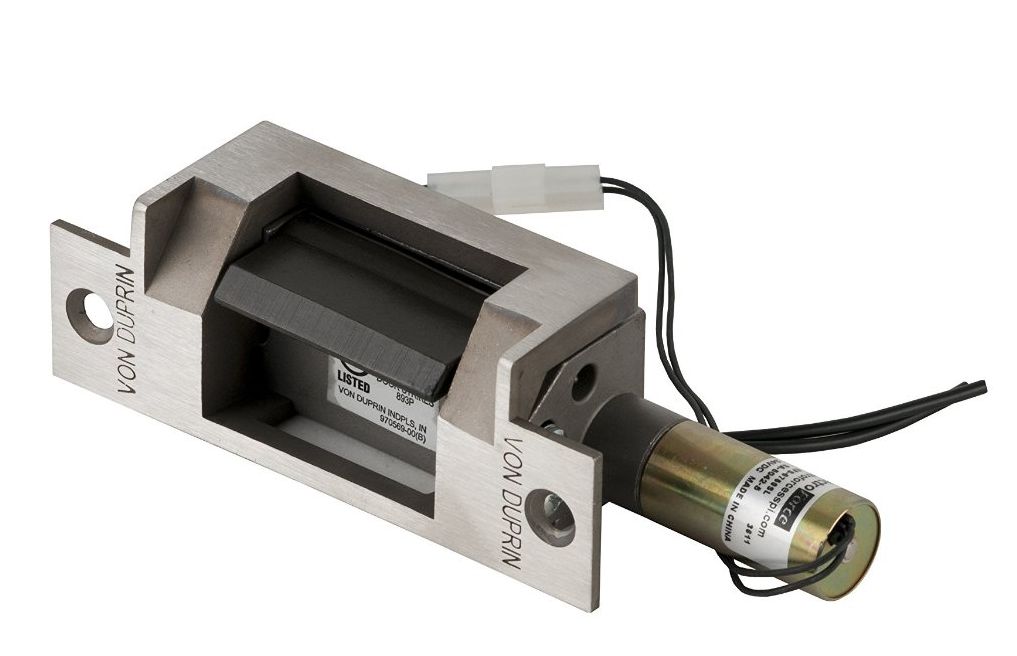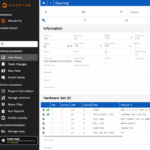 If you’re thinking…”I think she already wrote about this,” you’re right! A while back I had an article in Doors & Hardware about the requirement for electric strikes on fire door assemblies to be fail secure – this ensures that the keeper will remain closed to provide positive latching if power is cut. The article is here if you’d like a refresher.
If you’re thinking…”I think she already wrote about this,” you’re right! A while back I had an article in Doors & Hardware about the requirement for electric strikes on fire door assemblies to be fail secure – this ensures that the keeper will remain closed to provide positive latching if power is cut. The article is here if you’d like a refresher.
But recently a question from a code official landed in my inbox: “Can an electric strike on a fire door be operated by a motion sensor?” For example, if a door is often used by people carrying boxes or other large items, could a sensor release the strike so the building occupants can just push on the door rather than turning the lever to exit?
There is nothing in the codes that would prohibit the use of a sensor to release an electric strike in the direction of egress. The lever handle provides free egress manually so the sensor is only for convenience. But what if the smoke and/or heat from a fire caused the sensor to malfunction and the keeper to release? The door could then be left unlatched and unable to prevent the spread of smoke and flames.
The same thing could happen with a card reader if someone used a “toggle card” which unlocks the strike until the toggle card is used again. I think this application should be treated like electric latch retraction panic hardware – the latch projects (or the strike keeper is secure) upon fire alarm. This would require a fire alarm contact that may not currently be typical of electric strike installations.
Here’s the section from NFPA 80 that is usually applied to electric latch retraction. I don’t like the use of the term “fail-safe,” but it is not being used to mean a fail-safe strike in this instance:
6.4.4.3.3 Latching arrangements that do not provide positive latching in the normal mode shall be permitted to be used provided that, in a fire emergency, the door becomes positively latched by means of an automatic fail-safe device that is activated by an automatic fire detector.
Questions for you:
-
Should an electric strike on a fire door be required to be secure upon fire alarm, similar to electric latch retraction panic hardware?
-
If you specify or supply hardware, is this a function that you are currently including in your operational descriptions?
-
Do we need a code change to make this more clear, or is the NFPA 80 language above sufficient?
-
Should a motion sensor be allowed to release an electric strike on a fire door?
You need to login or register to bookmark/favorite this content.





1. Yes it should. I fail to see how this would work if you are in a situation where you need to have re entry.
2. I am not a fan of electric strikes on fire doors. The local AHJ, I don’t think, would go for it.
3. Yes. NFPA 80 is not the go to document. I would add this to the IBC, NFPA etc. so that there is a clear one stop shop so to speak. Dealing with code officials can be difficult enough at times.
4. I have mixed emotions. I can see a situation where there is a problem and the detector fails and the door is unlocked prior to alarm activation or alarm malfunction. If you were to use this you would have to have the fire alarm tied in to kill the strike power.
1. True – an electric strike is not the right product to use on a fire door if reentry is required. For reentry, you need a fail safe lock or fail safe panic hardware trim.
All my electric strikes are fail secure.I would say disable the motion upon fire alarm.
No, I have never specified a motion on a electric strike. I use motions on mag locks which release upon fire alarm along with retracted latches.
Code is clear enough electric strike have to be fail secure for positve latching.
Same as question 1 I would disable the motion if I did use one on a fire door, although more costly an exit device would be more appropriate.
Lori. Your blogs are always informative and thought provoking….thanx.
Dave
Thanks Dave. If an electric strike is used with a card reader or keypad, there is the possibility that the strike could be left unlatched with a toggle card or toggle code. So even though it’s a fail secure strike, the access control system could keep it unlatched indefinitely. I think we need a fire alarm contact even if there is a card reader on the access side rather than a motion sensor on the egress side.
Here at the University, we only use electrified panic trim or cylindrical locks for fire doors. On stairwell doors we use fail safe (electrically locked) trim tied to the Fire alarm system. We want our fire doors positively latched all the time. Our reasoning is that it is possible to use an electric strike, but sometime in the future, it could be unwittingly reprogrammed (rewired) to do something not compliant so we won’t install them. I can’t imagine our AHJ considering something tied to a motion sensor on a fire door that took away the positive latch and we would never ask him to.
On a separate note, most of our motion sensors are used as part of our keyless access systems and as a request to exit device at the doors. We wire them so that they mask the magnetic contact on the door for exiting, but do NOT automatically unlock the door. The reasoning being that someone passing or approaching a secured door to look outside will not unlock the door to a potential intruder just by being seen by the REX. Of course there are exceptions to everything, but personally I would like to see actual code address this issue. On fire doors, electronic access should unlock the device so that it can be operated by turning the lever handle but not become a free swinging door. “Nothing is foolproof – fools are too ingenious”
I don’t like electric strikes already but here is another reason
In the situation you are describing, I would follow the guide lines set forth for hold open devices. Smoke head on 1 or both sides of the door that that would shunt power to the strike. The release could be on general alarm, zoned detection, or just the smoke heads at the door, depending on the situation.
This is the way I treat all electronically dogged devices on fire rated doors. If the strike or latch retraction is limited to less than 10 seconds my AHJ does not require a fire alarm connection. The problem with this approach is the desired use may change over time and someone may change the 10 seconds to hours without realizing the strike is part of a fire door assembly.
A fire rated electric strike would be a good option for a rated door with an automatic operator. The A-O could provide power to the strike, and drop it out on fire alarm.
I would use the FA option board in the PS902 power supply and a fail secure strike. Using the 2RL option board as a place to land and control the motion sensor (inside) and card reader (outside), both supplying a dry contact closure upon activation, unlocking the door when signaled to do so. The FA board will shut down the power supply output to the strike during a fire alarm. Of course this door must swing in the direction of egress so the lockset would allow free egress. If reentry is required, it could be combined with a fail safe electric lock, again with an FA option board.
This way any changes to programming from the card reader would be overridden by the FA board in the power supply.
Matt: your proposal is good. It seems to satisfy all apprehensions in this blog about electric strike on fire door, unless someone could point out any other action that can change this configuration (e.g. re programming, etc..).